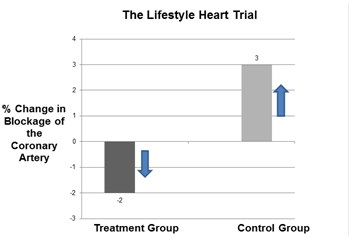Research shows that the more fit you are, the longer you can live. Regular exercise can improve your body and fitness even if you are living with heart disease.
Regular aerobic exercise can:
- improve your cardiovascular fitness. This means making your heart and lungs stronger and more efficient.
- make changes in your body composition such as:
- decreasing your waist size.
- decreasing your body fat.
- increasing your muscle mass.
- improve your blood glucose (sugar) levels.
- reduce your risk for heart disease.
Aerobic Activity and Heart Disease

Comparing the group who received the new treatment (diet, exercise stress management) and the group who received usual care (follow-up with doctor).
D. Ornish, S.E. Brown, J.H. Billings, L.W. Scherwitz, W.T. Armstrong, T.A. Ports, S.M. McLanahan, R.L. Kirkeeide, K.L. Gould, R.J. Brand.
Can lifestyle changes reverse coronary heart disease? (opens in new window) The Lancet, Volume 336, Issue 8708, Pages 129 - 133, 21 July 1990 Can aerobic activity help reverse the effects of heart disease? To answer this question, we turn to what research tells us.
The best type of research study is called a randomized control trial. In this type of study, the patients who are participating are divided into two groups:
- The experiment group (the people who get a special treatment)
- The control group (the people who don’t get the special treatment)
This type of study lets us compare the two groups, which tells us how effective a treatment is.
Dr. Dean Ornish, a doctor and researcher, did a randomized control trial to find out if lifestyle changes (like moderate exercise, low-fat vegetarian diet, and stress management) changed the amount of plaque in the coronary arteries of people living with heart disease.
Every patient in the study had an angiogram at the beginning of the study and at the end of the study, one year later. This allowed the researchers to measure the size of the blockages in their coronary arteries.
At the end of the study:
- the amount of plaque
got smaller by 2% in the group that received the nutrition, exercise and stress management program
- the amount of plaque
got bigger by 3% in the group that did not receive the program
This was a big finding!
Learn more about reversing heart disease »
